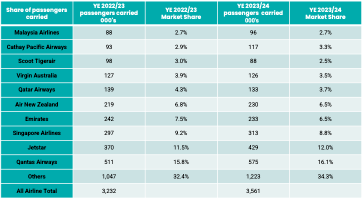SYDNEY, 18 October 2024: Australians are travelling at record levels, with outbound and inbound travel experiencing unprecedented growth in 2024, according to the latest Travel Trends Report from the Australian Travel Industry Association (ATIA).
The report, which analyses data from sources, including the Australian Bureau of Statistics and the Department of Infrastructure, shows a significant surge in outbound and inbound travel for the year ending August 2024. Australians are embracing international travel more than ever, with major increases to key destinations across the Asia-Pacific region.
Key outbound-travel insights
Indonesia continues to be the top destination for Australians, with a 30.4% increase in travellers, reaching 1.59 million.
Japan recorded the highest growth, with a 103.4% rise in Australian visitors, totalling 727,260 for the year.
Other key destinations include New Zealand (up 10.0% to 1.33 million) and the United States, which saw 728,550 Australian visitors, reflecting a 16.7% increase.
Key inbound-travel insights
China led the inbound market, with an astounding 135.5% increase in visitors, reaching 844,940 in 2024.
Growth from New Zealand visitors also remained strong, up 20.2% to 1.38 million, while visitors from Japan surged 64.9% to 373,700.
Overall, inbound tourism to Australia grew 25.7%, with 8.06 million international visitors in the year ending August 2024.
Australian travel-motivations
Holidays remain the primary reason for outbound travel, accounting for 60.2% of trips in August 2024.
Visiting friends and relatives comprised 26.7% of travel, while business travel showed modest growth, representing 5.8% of total trips.
Airline market share
Qantas continues to dominate international air travel, holding a 16.1% market share, followed by Jetstar at 12.0% and Singapore Airlines at 8.8%.
Airline share of passengers (international) year-on-year
ATIA’s October 2024 Travel Trends Report highlights that the strong growth in travel reflects Australia’s rebound from the pandemic, with Australians increasingly seeking new destinations and experiences. The industry is well-positioned for continued recovery and growth as consumer confidence strengthens and capacity expands.
“The incredible 30.4% year-on-year rise in travel to Indonesia, our top overseas destination, shows how much demand for international travel has skyrocketed,” commented ATIA CEO Dean Long. “ But it’s the growth in new and emerging markets that tell the story of 2024.”
“The 103.4% surge in travel to Japan is a clear sign that Australians are seeking more than just a getaway — they’re seeking cultural immersion and unique experiences. We’re seeing a shift towards more adventurous and diversified travel, with destinations like Thailand and Vietnam growing by 20.2% and 40.1%, respectively.”
“Our Oct Travel Trends Report also shows that travel to long-time favourites, New Zealand and the United States, continues to rise steadily, with growth rates of 10.0% and 16.7%, respectively. Australians have renewed confidence in international travel and are eager to explore near and far-flung destinations. Whether it’s the lure of vibrant cities, natural landscapes or cultural attractions, Australians travel more frequently and to a wider range of destinations than we’ve seen in recent years.”
“This strong momentum in outbound travel reflects a significant mindset shift compared to last year. Australians aren’t just travelling for holidays anymore — business travel is making a comeback, with a 5.8% rise this year, and visiting friends and relatives remains a major driver. What’s particularly encouraging is the consistency of this growth across almost all international markets. This is not a short-term rebound but a long-term trend showing Australians are eager to compensate for lost time.”
“Looking ahead, ATIA will continue to work closely with airlines and the broader travel industry to ensure Australians have the best travel options available. With demand surging, we must see an expansion in airline capacity and infrastructure to support the growing numbers. The travel landscape is evolving rapidly, and we are committed to ensuring that Australians can continue to explore the world in greater numbers, with more ease and flexibility.”







